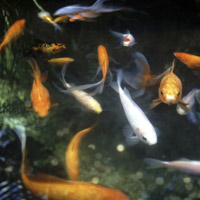3 Steps To Protect Koi Fish During Freezing Weather

Koi fish are beautiful and beloved additions to many backyard ponds. However, some pond owners don’t know how to keep their finned friends safe in freezing conditions when winter rolls around. The good news is that with some preparation and care, koi can successfully overwinter the outdoors in most climates.
Here’s everything you need to know about protecting koi fish when temperatures plunge.
Why Should You Winterize Your Koi Pond?
As cold-blooded creatures, koi fish naturally slow their metabolism and activity levels as water temperatures tumble. So, in the winter, they tend to settle to the bottom of the pond, where the water is slightly warmer.
Ice isn’t inherently harmful to koi, but a frozen pond surface can pose serious risks like lower oxygen levels. A pool that’s too shallow (less than 3–5 feet) can freeze solid in extreme cold.
To keep your koi healthy through winter, focus on maintaining adequate oxygen levels and seek to prevent the pond from completely freezing.
Key Steps for Winterizing a Koi Pond
Keeping koi safe in the winter is possible in a few ways. For example, you can move your fish and plants to a temporary indoor tank or install pond heaters that use a lot of energy.
Follow the three steps discussed below to winterize your koi pond.
Step 1: Use an Aerator
Have an aerator running in your pond at all times to keep the water stirred and promote the exchange of gases. An aerator is much cheaper to buy and maintain than a pond heater, which will oxygenate the water while reducing ice buildup.
To let koi retreat to calmer, deeper water if needed, the aerator’s diffuser should be halfway between the surface and the bottom of the pond. Set the aerator to provide a steady stream of bubbles rather than a “rolling boil,” or strong current.

Step 2: Create Ventilation Holes
A complete ice cover is dangerous for koi fish, which need a few feet of liquid water throughout the season. However, pond owners don’t need to keep the entire surface ice-free all winter. If you’re aerating the water, you only need a small hole or two for bubbles to escape.
To make ventilation holes, try placing a hot teakettle on the surface. You can also use your pool’s in-line heater (if it has one) or install a de-icer to keep at least part of the water above freezing. Never hit the ice to break it—this will spark powerful shockwaves in the water that may hurt the fish.
Keep an eye on your ventilation holes and have your teakettle ready to remove any thin ice before it thickens and hardens.
Step 3: Keep the Pond Clean and Balanced
Before winter, test the water for ammonia spikes and pH changes, and try to correct the balance as needed. However, avoid making large changes that could shock the fish.
Waste can accumulate in the pond through the season, so use a skimmer to remove fallen leaves and other organic matter. Also, keep your mechanical filtration system running to remove particles and maintain water clarity.
Feeding Koi in Cold Weather
When water temperatures dip below 50°F, the metabolism of koi fish drops so significantly that you shouldn’t feed them. Overfeeding in the wintertime can leave undigested food in the digestive tract of koi fish, resulting in health issues.
Use a pool thermometer for an accurate water temperature reading. If temperatures rise above 50°, feed the koi a small amount of low-protein, easily digested food formulated for cold water. Wheat germ-based foods are a good option for these occasional winter feedings.
Emergency Measures for Extreme Cold
Pond owners may need to take extra steps to protect their koi during a prolonged extreme cold or if their pond could freeze completely.
If a pond is close to freezing solid, adding warm water can help. Do this gradually so you don’t inadvertently shock the fish. Moving the koi to a temporary indoor tank of similar water quality might be the safest option for smaller ponds or areas with extremely harsh winters.






Leave a Reply